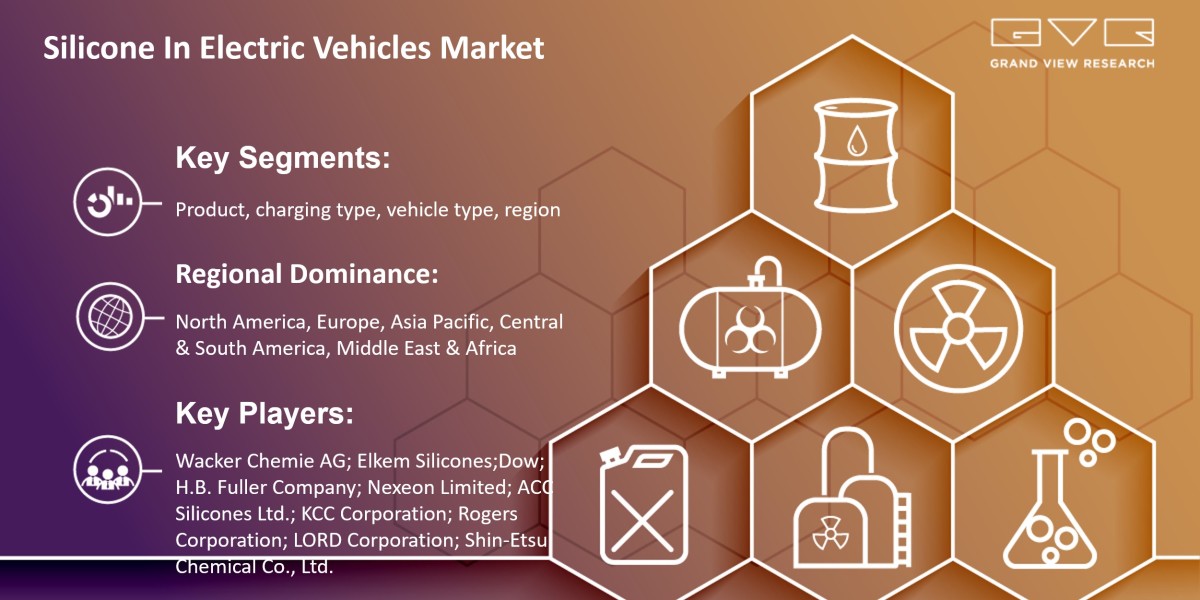San Francisco, 08 April 2024: The Report Silicone In Electric Vehicles Market Size, Share & Trends Analysis By Product (Elastomers, Fluids, Resins), By Charging Type (PHEV, BEV), By Vehicle Type (LMV, CMV), By Region And Segment Forecasts, 2024 - 2030
The global silicone in electric vehicles market is anticipated to reach USD 12.46 billion by 2030 and is anticipated to expand at a CAGR of 9.4% from 2024 to 2030, according to a new report by Grand View Research, Inc. The increasing production and sale of electric vehicles is driving the market. Silicone exhibits properties such as superior electrical insulation, thermal conductivity, chemical stability, flame retardancy, heat resistance, radiation resistance, moisture resistance, chemical resistance, and resistance to environmental factors such as humidity and light. The siloxane (-Si-O-Si-) bond, which is highly stable, imparts stability to silicone. The binding energy of siloxane (-Si-O-Si-) bond is 433 kJ/mol, which is higher compared to carbon bonds (C-C) at 355 kJ/mol. The low intermolecular force of silicone molecules imparts high elasticity, high compression ability, and improved temperature resistance to silicone
The thermal conductivity of silicone enables lowering the operating temperature, thus enhancing and extending the battery life in electric vehicles. Thermal properties offered by silicone also proves useful for PCB component systems of electric vehicles.
Silicone offers better temperature resistance at both high and low temperatures in comparison to other rubbers. It can withstand a higher temperature limit of up to 150°C and a lower temperature limit of up to -40°C. The temperature resistance property exhibited by silicone widens its application scope in electric vehicles. Silicone deteriorates in different ways. One of the ways is when it is heated in the presence of air. It deteriorates due to hardening, which affects the elongation of silicone. While the other includes operating under sealed conditions. Under this condition, silicone deteriorates due to softening, which is due to the degradation of siloxane bonding. However, adding a suitable curing agent before or after silicone curing is likely to prevent the softening of silicone under hot and sealed conditions.
Silicone, when exposed to wind, rain, UV rays, and ozone, can withstand the changes occurring in its physical properties. Silicone, when immersed in water or exposed to steam to a temperature limit of 150°C, has no impact on its mechanical and electrical properties. Polar organic compounds such as alcohol, aniline, dilute bases, and dilute acids may result in increasing the volume of silicone by 10% to 15% due to swelling.
These useful properties of silicone are projected to propel the demand for different forms of silicone for use in an electric vehicle over the forecast period. The increasing use of rubber components to achieve weight reduction in the automotive industry is likely to boost the demand for rubber components. The increased demand for rubber components is, in turn, likely to fuel the growth of silicone rubber which impart various advantageous properties to rubber, and hence, finds use in electric vehicle components which is expected to propel the market demand of silicone over the forecast period.
Request sample report of Silicone In Electric Vehicles Market@ https://www.grandviewresearch.com/industry-analysis/silicone-in-electric-vehicles-ev-market/request/rs1
Surging demand for electric vehicles is one of the primary growth stimulants for the market. This is further supported by increasing favorable regulations toward reducing greenhouse gas emissions and lowering the impact of air pollution that are influencing the growth outlook for electric vehicles. Different financial measures such as tax incentives, purchase incentives, tax rebates, tax waivers, bonuses, and others also support the rise in electric vehicles.
Silicone In Electric Vehicles Market Report Highlights
- The elastomers segment is expected to grow at the fastest CAGR of 9.8% during the forecast period 2024-2030. Elastomer was the most prominent silicone product segment in the electric vehicle market in 2023. The growth of this segment can be attributed to its wide range of applications such as housings, gaskets, and seals, for thermal insulation of various components such as portable control unit (PCU) housing and connector sealing.
- The battery electric vehicle (BEV) segment accounted for a market share of 66.8% in 2023. The increasing production and demand for battery electric vehicles globally are propelling the consumption of silicone in the automotive industry.
- The light motor vehicle (LMV) segment is expected to grow at a CAGR of 9.5% during the forecast period. Silicones are known for their excellent thermal stability. In electric vehicles, efficient thermal management is crucial to maintain optimal operating temperatures for batteries and electronic components. Silicone is also used in light motor vehicles for weight reduction, as silicone materials are lightweight.
- Asia Pacific dominated the market and accounted for a market share of 43.8% in 2023. This is attributed to the large-scale production of electric vehicles in the Asia Pacific region, with China being the world's largest producer of electric vehicles.
- In October 2022, Dow, a U.S.-based company, launched a new silicone product i.e., SiLASTIC SST-2650 self-sealing silicone, marking the world's inaugural recyclable solution for self-sealing tires made of silicone. Bridgestone has seamlessly integrated this innovative technology into their newly introduced B-SEALS, a tire sealant system designed with recyclability in mind.
In addition, electric vehicle rollout plans are also supported by non-financial measures, including fast charging stations available in public areas, free parking, separate lanes for EVs, and other similar measures. These financial and non-financial measures together are expected to drive the growth of electric vehicles, which in turn is projected to drive silicone demand growth in the electric vehicle market over the forecast period. However, silicone substitutes, such as plastics and other types of rubber products used in electric vehicles, may lead to an increase in silicone content in electric vehicles during the forecast period.
Several US states, including New Jersey, California, Washington, and Louisiana, provide tax credits, incentives, and rebates for the purchase of electric vehicles (EVs). New Jersey and Washington are exempt from the tax on the sale and use of electric vehicles, and California is offering discounts on plug-in hybrid electric vehicles (PHEVs) and other zero-emission passenger cars. Tax credit programs being implemented by various US states are likely to boost demand for electric vehicles, which in turn is projected to drive silicon growth in the electric vehicle market during the forecast period.
Electric vehicles (EVs) are expected to be widely used in Europe, Asia-Pacific, and North America due to stringent government initiatives in these regions to curb air pollution. It is predicted that the growing demand for environment-friendly transport will also drive the demand for electric vehicles in the coming years. The growing use of silicone in various electric vehicles such as plug-in hybrid electric vehicles (PHEVs) and battery electric vehicles (BEVs) is driving the growth of the market.
Silicone In Electric Vehicles Market Report Scope
Report Attribute | Details |
Market size value in 2024 | USD 7,282.1 million |
Revenue forecast in 2030 | USD 12.46 billion |
Growth rate | CAGR of 9.4% from 2024 to 2030 |
Base year for estimation | 2023 |
Historical data | 2018 - 2022 |
Forecast period | 2024 - 2030 |
Market growth stage is medium, and pace of the market growth is accelerating. The market is characterized by a high degree of innovation owing to the rapid technological advancements. The market is also characterized by a high level of merger and acquisition (M&A) activity by the leading players. This is due to several factors, including the desire to gain access to new production technologies and talent, need to consolidate in a rapidly growing market.
List of Key Players in the Silicone In Electric Vehicles Market
- Wacker Chemie AG
- Elkem Silicones
- Dow
- H.B. Fuller Company
- Nexeon Limited
- ACC Silicones Ltd.
- KCC Corporation
- Rogers Corporation
- LORD Corporation
- Shin-Etsu Chemical Co., Ltd.








